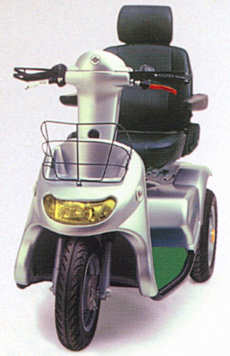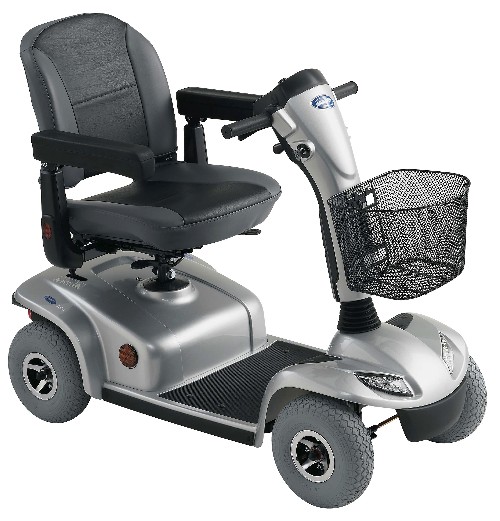Short Description
A battery powered three wheeled scooter for outdoor and limited indoor use. It has rear shock absorbers and large wheels designed for use over rough terrain. The seat is also fitted with a shock absorber. Features a headlight and indicator / hazard lights. Contoured cowling covers the front wheel to give the appearance of a motorbike. Dismantles for transportation.
Options
cover - sun canopy
Models
Only one model is available
| Specification |
Standard |
| Backrest Height |
Unknown |
| Base Height (clearance) |
125 mm |
| Length |
1448 mm |
| Load Capacity (supplier stated) |
160 kg |
| Seat Depth |
Unknown |
| Seat Height |
Unknown |
| Seat Width |
Unknown |
| Weight (kg) |
Unknown |
| Weight of Heaviest Part |
Unknown |
| Width |
670 mm |
Additional Dimensions
Turning Radius: 1397mm
Weights:
Total w /out batteries 85kg
With batteries 130kg
Battery weight 2 x 20kg
Climbing Ability:
Maximum slope angle 11.85
Obstacle climbing ability 125mm
More Details
It has front and rear shock absorbers and large wheels designed for use over rough terrain. The seat, which swivels and locks at 45 and 90 degrees, is also fitted with a shock absorber. Also has a rear vision mirror and mud flaps.
TRANSPORTING handles, seat and front wheel are removable for transport
FREEWHEELING switch on handle controls
BATTERY CHARGING is achieved by connecting the charger provided to a mains power point and plugging it into the scooter at the marked charging terminal on the tiller. Charger: 24 VDC, Max 10A
BATTERIES 2 x 12v 40 amp/hr (can take up to 70 amp/hr)
REAR WHEELS 250mm diameter pneumatic.
FRONT WHEEL 250mm diameter pneumatic.
FOOTSPACE on flat platform
SEAT is a solid padded with lift up arms and an adjustable backrest. Operating lever for seat swivel may be situated under the left or right hand side of the seat. Seat slides backwards and forwards. Can be adjusted in height.
CONTROLS can be programmed to increase / limit speed
Speed switch, battery charge indicator, horn (right and left side), indicator switch, speed switch - two forward speeds; one reverse speed
Hand brake on left side (pull towards user to operate)
Accelerator handle on right side (pull towards user to increase speed, release to slow down (automatic stop)
LIGHTS powerful headlight
BRAKES Electromagnetic Automatically engage when throttle is release. Brake lights.
BASKET attaches to the front of the tiller
Factors To Consider
Transport Accessibility
The space allowed on public transport for carrying mobility equipment is an area of 1300mm by 800mm.
Overall length of this scooter ...........1448 mm
Overall width of this scooter ........... 670 mm
State transit will only carry scooters with an unladen weight of less than 200 kg and which can be driven onto the bus, and manoeuvred to fit wholly within the designated wheelchair space under their own power. Any such scooters carried must also comply where relevant with the rules applying to wheelchairs.
Three wheeled mobility aids of any kind are unstable in normal bus operations and will not be carried because of the safety risk.
Accessible buses display a blue and white wheelchair sign on the front of the bus, and on the easy access door.
Factors applying to all scooters
* This item should be trialled in the user's own environment to ensure maximum safety and independence. Environmental considerations include eg: kerbs, footpaths, tram and railway crossings, street crossings, etc
* Users should take care when riding a scooter or powered wheelchair and observe the following safety guidelines:
* Users who intend to use scooters or powered wheelchairs must ensure they have the necessary physical and cognitive skills to operate and manoeuvre them safely
* Stay within the legal speed limit of 10km/h
* Be aware that taking medication or driving under the influence of alcohol may affect the user's judgement
* Always make sure that you are clearly visible, particularly at night or on dull days-use the lights and reflectors and install a reflective flag high enough to be seen by motorists
* Wear a bicycle helmet whenever possible
* Slow down when you are near other people, especially pedestrians and cyclists
* Avoid stopping or driving on inclines greater than your scooter is designed for
* Use footpaths if possible. If there are no foot paths, plan to user quieter roads
* Plan your trip and avoid uneven surfaces, dips and potholes
* Ensure if you are carrying parcels that the load will not over-balance your scooter and the parcels do not interfere with your controls or vision
Maintenance
Refer to supplier / manufacturer manual for maintenance details and safety warnings.
Licence & Insurance Requirements
Registration requirements
In NSW, motorised wheelchairs that weigh less than 110 kg and cannot travel at more than 10 km/h do not have to be registered, provided they are being used by a person with mobility problems. A person driving a motorised wheelchair under these circumstances is defined as a pedestrian under the Australian Road Rules and is permitted to travel on a footpath or nature strip adjacent to the road.
Vehicles exempt from registration are covered by the nominal defendant scheme (administered by the Motor Accidents Authority) if they are at fault in an accident in NSW on a road or road-related area and cause injury to another person. However, this cover is only valid in NSW.
Standards
Some assistive technology needs to meet Australian or other standards. Standards may relate to materials, manufacturing and installation. Products that meet Australian or international standards will have written certification. To find out if a product meets Australian Standards ask the supplier to show you the certificate. For more information about standards also see
www.ilcnsw.asn.au/home/assistive_technology/standards
Place Of Manufacture
Afikim Electric Mobilisers (Israel)



 subscribers
subscribers 



